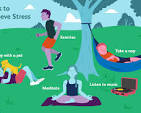Exercise is an essential component of a healthy lifestyle. It not only helps us maintain physical fitness but also has numerous mental health benefits. Regular exercise can help reduce stress, boost mood, improve cognitive function, and decrease the risk of chronic diseases such as heart disease and diabetes.
One of the most significant benefits of exercise is its ability to reduce stress. When we exercise, our bodies release endorphins, which are natural feel-good chemicals that can help reduce feelings of anxiety and depression. Exercise also helps lower levels of cortisol, a hormone that is associated with stress.
In addition to reducing stress, exercise can also boost mood. Studies have shown that regular exercise can be as effective as medication for treating depression in some cases. Exercise releases neurotransmitters such as serotonin and dopamine, which are responsible for regulating mood and feelings of pleasure.
Another important benefit of exercise is its ability to improve cognitive function. Regular physical activity has been shown to enhance memory, concentration, and overall brain function. Exercise increases blood flow to the brain, which can help improve cognitive performance.
Exercise can also help prevent chronic diseases such as heart disease and diabetes. Regular physical activity helps maintain healthy blood pressure levels, reduces inflammation in the body, and improves insulin sensitivity. These factors all contribute to a decreased risk of chronic diseases.
It’s important to note that exercise doesn’t have to be intense or time-consuming to be beneficial. Even moderate-intensity activities such as brisk walking or gardening can provide health benefits when done regularly.
Incorporating exercise into your daily routine doesn’t have to be difficult either. Simple changes such as taking the stairs instead of the elevator or going for a walk during your lunch break can make a big difference in your overall health.
In conclusion, regular exercise is an essential component of a healthy lifestyle with numerous mental and physical health benefits. Whether it’s through high-intensity workouts or simple daily activities, finding ways to incorporate physical activity into your routine can have a significant impact on your overall well-being.
5 Benefits of Exercise for a Healthier Body and Mind
- Improves mental health and mood
- Strengthens bones and muscles
- Increases energy levels
- Helps maintain a healthy weight
- Reduces stress and anxiety
4 Drawbacks of Exercise: Injury Risk, Time Commitment, Cost, and Plateaus
Improves mental health and mood
Exercise is not just good for your physical health, it can also have a significant impact on your mental health and mood. Studies have shown that regular exercise can help reduce symptoms of anxiety and depression, boost self-esteem, and improve overall mood.
When we exercise, our bodies release endorphins, which are natural feel-good chemicals that can help reduce feelings of stress and anxiety. Exercise also helps to lower levels of cortisol, a hormone that is associated with stress. This can lead to improved mental clarity and a more positive outlook on life.
Regular exercise has also been shown to be an effective treatment for depression in some cases. In fact, some studies have found that exercise can be just as effective as medication for treating mild to moderate depression. Exercise releases neurotransmitters such as serotonin and dopamine, which are responsible for regulating mood and feelings of pleasure.
In addition to reducing symptoms of anxiety and depression, regular exercise can also boost self-esteem. When we exercise regularly and see improvements in our physical fitness or appearance, it can help us feel more confident and positive about ourselves.
Overall, the benefits of exercise on mental health and mood cannot be overstated. Whether it’s through high-intensity workouts or simple daily activities like walking or yoga, finding ways to incorporate physical activity into your routine can have a significant impact on your overall well-being.
Strengthens bones and muscles
Exercise is not only beneficial for our mental health but also plays a crucial role in strengthening our bones and muscles. Regular physical activity can help prevent osteoporosis and improve muscle strength, which is important for maintaining a healthy body.
As we age, our bones become weaker, and we are at a higher risk of developing osteoporosis. However, regular exercise can help prevent this by increasing bone density. Weight-bearing exercises such as walking, running, and weightlifting have been shown to be particularly effective in strengthening bones.
In addition to improving bone health, exercise also helps build muscle strength. This is important for maintaining balance and stability, which can help prevent falls and injuries. Strength training exercises such as push-ups, squats, and lunges are effective in building muscle mass.
It’s important to note that exercise doesn’t have to be intense or time-consuming to be beneficial for bone and muscle health. Even simple activities such as walking or gardening can provide benefits when done regularly.
In conclusion, regular exercise is crucial for maintaining healthy bones and muscles. Whether it’s through weight-bearing exercises or simple daily activities, finding ways to incorporate physical activity into your routine can have a significant impact on your overall well-being. So why not take the first step towards a healthier lifestyle today by incorporating some form of exercise into your daily routine?
Increases energy levels
Exercise is not only good for your physical health but also has a significant impact on your energy levels. One of the most significant benefits of exercise is its ability to increase energy levels. Exercise can help boost your mood, reduce fatigue, and improve overall cognitive function.
When we exercise, our bodies release endorphins, which are natural feel-good chemicals that can help reduce feelings of fatigue and boost mood. Exercise also helps improve blood flow and oxygen delivery to the muscles and organs, which can increase energy levels.
Regular exercise can also help improve sleep quality, which is essential for maintaining high energy levels throughout the day. When we get enough restful sleep, our bodies are better equipped to handle daily tasks with more focus and efficiency.
In addition to improving physical energy levels, exercise can also have a positive impact on mental energy. Studies have shown that regular physical activity can improve cognitive function and reduce symptoms of depression and anxiety.
It’s important to note that exercise doesn’t have to be intense or time-consuming to be beneficial for increasing energy levels. Even short bursts of physical activity such as a 10-minute walk or some light stretching can provide an immediate boost in energy.
In conclusion, regular exercise is an excellent way to increase energy levels naturally. Whether it’s through high-intensity workouts or simple daily activities, finding ways to incorporate physical activity into your routine can have a significant impact on your overall well-being and productivity throughout the day.
Helps maintain a healthy weight
Exercise is a proven way to help maintain a healthy weight. When we exercise, our bodies burn calories, which helps us lose weight or maintain a healthy weight. Regular physical activity also helps build muscle mass, which can increase our metabolism and help us burn more calories even when we’re not exercising.
In addition to burning calories, exercise can also help control appetite and reduce cravings for unhealthy foods. Studies have shown that regular exercise can decrease levels of the hunger hormone ghrelin and increase levels of the satiety hormone leptin, leading to decreased feelings of hunger and increased feelings of fullness.
It’s important to note that exercise alone may not be enough to achieve significant weight loss. A healthy diet is also essential for maintaining a healthy weight. However, regular physical activity can be an effective tool in combination with a balanced diet for achieving and maintaining a healthy weight.
Incorporating exercise into your daily routine doesn’t have to be difficult either. Simple changes such as taking the stairs instead of the elevator or going for a walk after dinner can make a big difference in your overall health and help you maintain a healthy weight.
In conclusion, regular exercise is an effective way to help maintain a healthy weight by burning calories, building muscle mass, controlling appetite, and reducing cravings for unhealthy foods. By incorporating physical activity into your daily routine and combining it with a balanced diet, you can achieve and maintain a healthy weight for optimal health and well-being.
Reduces stress and anxiety
Exercise is a powerful tool that can help reduce stress and anxiety. When we exercise, our bodies release endorphins, which are natural chemicals that help us feel good and reduce feelings of anxiety and depression. Exercise also helps lower levels of cortisol, a hormone that is associated with stress.
Regular exercise has been shown to have significant mental health benefits. Studies have found that people who exercise regularly are less likely to experience symptoms of anxiety and depression than those who don’t. Even just a few minutes of physical activity can help alleviate stress and improve mood.
In addition to its mental health benefits, exercise can also improve physical health. Regular exercise has been shown to reduce the risk of chronic diseases such as heart disease and diabetes. It also helps maintain healthy blood pressure levels, reduces inflammation in the body, and improves insulin sensitivity.
There are many ways to incorporate exercise into your daily routine, from high-intensity workouts at the gym to simple activities such as walking or gardening. Finding an activity that you enjoy can make it easier to stick with an exercise routine over time.
In conclusion, regular exercise is an effective way to reduce stress and anxiety while improving overall physical and mental health. Whether it’s through intense workouts or simple daily activities, finding ways to incorporate physical activity into your routine can have a significant impact on your well-being.
Risk of Injury
While exercise has many benefits, it’s important to acknowledge the potential risks associated with physical activity. One of the most significant cons of exercise is the risk of injury. Exercise puts strain on the body, which can lead to injuries such as sprains, strains, and broken bones.
Injuries can occur for a variety of reasons, including improper form, overexertion, and lack of warm-up or cool-down. It’s essential to listen to your body and not push yourself beyond your limits. If you feel pain or discomfort during exercise, it’s important to stop and assess the situation.
To reduce the risk of injury during exercise, it’s important to take precautions such as wearing appropriate clothing and footwear, using proper equipment, and warming up before starting any physical activity. It’s also important to gradually increase the intensity and duration of your workouts over time rather than jumping into high-intensity exercises right away.
Injury prevention should be a priority for anyone engaging in physical activity. While injuries can be frustrating and setback progress towards fitness goals, they can also have long-term consequences if not properly treated. In some cases, injuries may require medical attention or even surgery.
In conclusion, while exercise has many benefits for our mental and physical health, it’s important to acknowledge the potential risks associated with physical activity. The risk of injury can be reduced by taking proper precautions such as warming up before exercising and gradually increasing intensity over time. By being mindful of our bodies’ limits and taking steps to prevent injury during exercise, we can continue reaping the many benefits that regular physical activity provides.
Time Commitment
One of the biggest cons of exercise is the time commitment required to see results. Exercise requires a significant investment of time and effort in order to achieve the desired outcomes, whether it’s weight loss, muscle gain, or improved cardiovascular health.
Many people struggle to find the time to exercise regularly due to busy schedules and other commitments. It can be challenging to carve out time for exercise when there are so many other demands on our time, such as work, family obligations, and social activities.
In addition to the time commitment required for exercise itself, there is also the preparation time involved. This includes getting dressed in appropriate workout attire, packing a gym bag if necessary, and commuting to and from the gym or workout location.
Furthermore, some people may find that they need additional time for recovery after exercise. This may include stretching or foam rolling to prevent soreness or injury.
Despite these challenges, it’s important to remember that even small amounts of exercise can have significant health benefits. Incorporating physical activity into your daily routine doesn’t have to be time-consuming or difficult. Simple changes such as taking a brisk walk during your lunch break or doing a few minutes of stretching before bed can make a big difference in your overall health.
Ultimately, finding ways to incorporate regular physical activity into your routine is essential for maintaining good health and well-being. While it may require some effort and commitment upfront, the long-term benefits are well worth it.
Cost
One of the most significant drawbacks of exercise is its cost. Exercise equipment and gym memberships can be expensive, making it difficult for some people to afford exercise activities. This can be a significant barrier for those who are on a tight budget or have limited financial resources.
Gym memberships can be particularly costly, with some facilities charging hundreds of dollars per year. Many people simply cannot afford this expense, especially if they are already struggling to make ends meet.
Exercise equipment can also be expensive, with items such as treadmills and weight machines costing thousands of dollars. While there are more affordable options available, such as resistance bands and yoga mats, these items may not provide the same level of workout as more expensive equipment.
The cost of exercise can also extend beyond just equipment and gym memberships. Some types of exercise require specialized clothing or shoes, which can add up quickly in terms of cost. Additionally, certain activities such as personal training sessions or fitness classes may come at an additional cost.
Despite the cost associated with exercise, it’s important to note that there are still many ways to stay active without breaking the bank. Walking or jogging outside is free and requires no equipment other than a comfortable pair of shoes. Bodyweight exercises such as push-ups and squats require no equipment at all.
Additionally, many communities offer free or low-cost fitness programs through local parks and recreation departments or community centers. These programs may include group fitness classes or access to gym facilities at a reduced cost.
In conclusion, while the cost of exercise can be a significant barrier for some people, there are still many affordable options available. By getting creative with workout routines and taking advantage of community resources, anyone can find ways to stay active without breaking the bank.
Plateaus
While exercise is undoubtedly beneficial, there are some potential downsides to consider. One such con of exercise is plateaus. After reaching a certain level of fitness, it can be challenging to progress further due to plateaus in progress or motivation levels.
Plateaus occur when the body adapts to a particular exercise routine, and progress slows or stops altogether. This can be frustrating for individuals who have been working hard to achieve their fitness goals. Plateaus can also lead to a loss of motivation, as individuals may feel like they are not making any progress despite their efforts.
To overcome plateaus, it’s essential to mix up your exercise routine regularly. This could involve trying new exercises or increasing the intensity or duration of your current workouts. Incorporating strength training into your routine can also help break through plateaus by building muscle and increasing overall fitness levels.
It’s also important to remember that progress may not always be linear. There will be ups and downs along the way, and it’s important not to get discouraged by temporary setbacks. Keeping a positive attitude and celebrating small victories along the way can help maintain motivation levels.
In conclusion, while plateaus in progress or motivation levels can be a con of exercise, they are not insurmountable obstacles. By mixing up your routine regularly and staying positive, you can overcome these challenges and continue making progress towards your fitness goals.



